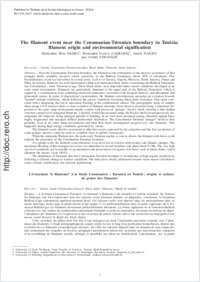The filament event near the Cenomanian-Turonian boundary in Tunisia: filament origin and environmental signification
- Negra, Mohamed Hédi University of Tunis El Manar, Tunis Faculty of Sciences, Tunisia
- Zagrarni, Mohamed Faouzi University of Gabes, Institut Supérieur des Sciences et Techniques des Eaux, Tunisia
- Hanini, Amine University of Tunis El Manar, Tunis Faculty of Sciences, Tunisia
- Strasser, André University of Fribourg, Department of Geosciences, Switzerland
-
2011
Published in:
- Bulletin de la Société Géologique de France. - 2011, vol. 182, no. 6, p. 507-519
English
Near the Cenomanian-Turonian boundary, the filament event corresponds to the massive occurrence of thin elongate shells, probably bivalves which constitute, in the Bahloul Formation, about 40% of allochems. This biosedimentary event was described in several areas, such as in Tunisia, Algeria, Morocco, North America, Oman and Tibet. In Tunisia, filaments are well represented within well laminated black shales constituting the Bahloul Formation, late Cenomanian – early Turonian in age. These black shales were deposited under anoxic conditions developed in an outer ramp environment. Filaments are particularly abundant in the upper part of the Bahloul Formation, which is topped by a condensation level exhibiting encrusted ammonites associated with frequent burrows, and phosphatic and glauconitic grains. In terms of depositional environments, the filament concentrations announce an evolution towards “normal”-marine conditions, which followed the anoxic conditions favouring black-shale formation. This trend coincided with a deepening that led to maximum flooding at the condensation surface. The petrographic study of samples taken along a N-S transect shows a clear evolution of filament structures from distal to proximal ramp. Limestones deposited in the outer ramp environment mainly contain well preserved “pelagic” bivalve shells showing a thin-shelled structure composed of elongated filaments. Laterally, toward the proximal ramp, the bivalve shells are progressively disintegrated, the filaments being arranged parallel to bedding. In an even more proximal setting, filaments appear finer, highly fragmented and arranged without preferential orientation. The Cenomanian-Turonian “pelagic” bivalves thus probably lived in an outer ramp environment and their thin shells disintegrated progressively into filaments. This happened during high energy conditions generated by storms.The filament event, which is associated to other bio-events expressed by the extinction and the first occurrence of some pelagic species, could be used to establish local to global correlations.When the ammonite Watinoceras, the main early Turonian marker, is rare or absent, the filament-rich facies could indicate the proximity of the Cenomanian-Turonian boundary.At a global scale, the filament event illustrates a sea-level rise in relation with eustatic and climatic changes. The maximum flooding of this transgressive event was identified in several localities and dated about 93 Ma. The very high sea-level conditions are favourable to accumulation and preservation of organic-rich facies such as black shales, which illustrate the anoxic event OAE2.The abundance of filaments near the Cenomanian-Turonian boundary is an indicator of high organic productivity following a climatic change to warmer conditions. The latter have clearly influenced oceanic water-masses circulation, water column stratification and nutrient partitioning.
- Faculty
- Faculté des sciences et de médecine
- Department
- Département de Géosciences
- Language
-
- English
- Classification
- Palaeontology
- License
- License undefined
- Identifiers
-
- RERO DOC 28751
- DOI 10.2113/gssgfbull.182.6.507
- Persistent URL
- https://folia.unifr.ch/unifr/documents/302209
Statistics
Document views: 99
File downloads:
- str_fen.pdf: 214
